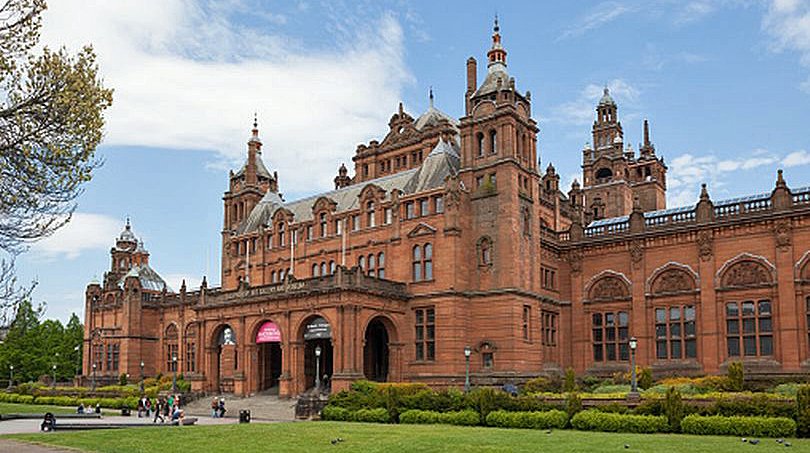Jon Trevelyan (UK)
Once I went as much as Glasgow to attend my son’s commencement, I intentionally made a while to go to Kelvingrove Art Gallery and Museum to discover its 22 galleries. These cowl all the things from artwork to animals, Historical Egypt to Charles Rennie Waterproof coat and far, rather more moreover. Nevertheless, the rationale why I’m together with Kelvingrove in my collection overlaying the geology museums of Britain, and the actual purpose for my go to, is its attractive assortment of fossils, specifically, vital ones discovered from Scotland and, certainly, in and round Glasgow.
Positioned within the stunning Kelvingrove Park (Fig. 1), the artwork gallery and museum opened in 1901 and is clearly a agency favorite with native folks and guests. It has gorgeous structure (Fig. 2) and a household pleasant ambiance; and has comparatively not too long ago been redesigned – with out dropping its Victorian traditions and beliefs – in order that it’s upgraded for the twenty-first century.


In truth, Kelvingrove began life as typical Victorian museum (Fig. 3), based by (because the information places it):
… the rich lessons to say their cultural value and enhance the folks of the town”.

Nevertheless, as I say, there have been enhancements, which had been achieved by asking Glasgow residents what they authorised of the museum, and what they wished from it sooner or later (together with the recommendations of its skilled workers – curators, conservators, customer assistants, educators and the like). Amongst different issues, the end result was double the variety of objects on view (a particular plus for me, who believes that museums ought to include plenty of objects to take a look at, and never simply images and IT buttons to press). There’s additionally a altering programme of short-term exhibitions and shows.
The palaeontology reveals are displayed within the Creatures of the Previous gallery and embody dinosaurs, Carboniferous tropical forests, and coral seas, and the early (Devonian and Carboniferous) fish that Scotland has grow to be well-known for (Figs. 4 and 5).


Included is also a uncommon fossil of a water scorpion (eurypterid), found in 1830 and referred to as Hibbertopterus or ‘Scouler’s Auld Heid’ (Figs. 6 and seven) after its discovery and likeness to a human head. Solely the pinnacle, two physique segments and a few of the legs are preserved, however it’s properly value seeing. This arthropod grew to a frightening size of 1.5m and consumed small animals sifted from the water; and fossil trackways recommend that it might additionally stroll and survive on land.


The skeletal cast of carnivorous dinosaur, Ceratosausus nasicornisis, is the most dramatic exhibit (Fig. 8). This species (and the original skeleton) was actually found in the USA, but a leg bone – whose features suggest it is from a related predatory dinosaur – has been found on the Isle of Skye, which seems to have become Scotland’s dinosaur island (see Geology museums of Britain: Staffin (Dinosaur) Museum, Isle of Skye).

Other large reptiles have been found in Scotland in the Elgin area, including Stagonolepsis robertsoni (Fig. 9). The collection has a full-size reconstruction and a few fossils of its bones and scales. It grew to about 2.7m long and was a herbivore. This and other fossils of huge reptiles have been found at Elgin in northeast Scotland, from sediments from about 220 Ma, at the beginning of the Triassic.

There is also a lovely example of Chirotherium footprints, also from the Triassic, but this time from England (Fig. 10).

There are also plenty of less dramatic, but no less interesting fossils. These are of: terrestrial animals like pterosaurs (Fig. 11 and 12) and birds (Fig. 13); marine fossils like ammonites and nautilus (Fig. 14), brachiopods (Fig. 15) and crinoids (Fig. 16); and plants from tropical forests, testament to Scotland’s industrial past and its extraction of coal from its Upper Carboniferous sediments (Figs. 17, 18 and 19).









There is also a nice collection of Scottish Ice Age animals, with the skeleton of a huge Irish deer (Megaloceras giganteus) holding court over the Creatures of the Past gallery (Fig. 20). Notwithstanding that this particularly magnificent specimen was found in County Dublin in Ireland, remains of the species have also been found in Scotland.

Other local finds from this time (that is, found in or near Glasgow) include a reindeer antler (Rangifer tarandus, found at Mount Florida, Glasgow), a tooth from a woolly mammoth (Mammuthus primigenius, from Kenmuir Hill, Glasgow) and the leg from a woolly rhinoceros (Coelodonta antiquitatis, from Bishopbriggs, Glasgow). It is estimated that these all date from about 27,500 years ago and all are from the local area, showing that this truly is a local museum.
During my time in Glasgow, I also visited the Hunterian, which is part of Glasgow University. I will cover that next week.
I thoroughly enjoyed my visit to Kelvingrove, so heartly recommend a visit.

| Address |
|---|
| Argyle Street Glasgow G3 8AG |
Trending Products










